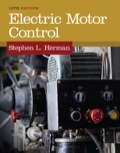
Concept explainers
Explain the operating principle for all three-phase motors.
Explanation of Solution
Discussion:
The three-phase AC motors work on the principle of rotating magnetic field (RMF). When the three-phase supply is connected to stator of the motor, the three-phase currents induce the three flux waves. The fluxes interact with each other and produce the RMF. The speed of the RMF is a synchronous speed.
The synchronous speed of RMF depends on the number of poles per phase and the applied voltage’s frequency. The electromotive force (EMF) is induced in the rotor conductors due to the RMF. The induced EMF on the rotor leads to the flow of current in the rotor conductors, and subsequently rotor torque is produced. The rotor rotates in the direction of RMF due to the rotor torque.
Conclusion:
Thus, the operating principle of all three-phase motors is explained.
Want to see more full solutions like this?
Chapter 55 Solutions
Electric Motor Control
- A 3-phase, 50 Hz, 132 kV overhead line transpose system of bundle conductors .a radius of conductor is 0.5 cm. Calculate the total inductance of the line. 4m bi 4m C1 C1 im am biarrow_forwardInth big below:- A 500m B Zoom с 180011 I=50A I-60A I-804 06 ·0.7 0.8 lag. unit) Teading Pf P.F Pl A I sing phase distributor of 3/cm = The distance from point A To B is 500m distance from point A To C is /200m The distance from point A To D is 3000m The impedance of each part is. ZAB-0.51j0.8 -2/km ZBC= 0.7+71.2 12/1cm ZCD = 1.3772.5 -2/1cm The voltage of end for is VD= 220 Volt Find : 1- sending Voltage senting power 2- 5arrow_forwardConsider the circuit diagram below, where the load is indicated by the dashed box. Compute the apparent power and power factor of the load. Use power factor correction to correct the power factor of the load to 0.8 lagging. Your solution should include a circuit diagram of your modified circuit.arrow_forward
- Consider the circuit diagram below. What is the power factor of the circuit? Is it leading or lagging? Draw the power factor triangle of the circuit without calculating the individual power consumption of each component.arrow_forwardExplain what is wrong with each diagram in Fig. 6.41 if the two op amps are known to be perfectly ideal.arrow_forwardAmplitudes are given in peak values. Use node analysis to determine the voltage at nodes a and b. Express the voltages as sinusoids in the time domain with phase angles measured in radians. You may solve the system of equations using MATLAB or a similar software, but you must include the code you ran as part of your solution.arrow_forward
- Q3a [3 points] Simplify the following Boolean function using K-map: f= (0,2,8,9,10,12) & don't care X= (1,7,14) Put each cell number in the cell left upper corner. Put 1, O or X inside each cell. Circle your groups Write the simplified function f in terms of x, y, z and w ESM MZ f= Q3b [2 point] Design the above simplified Boolean function f after k-map using iCircuit then post your design screenshot here:arrow_forwardQ1a [2 points] Convert the binary into octal and hexadecimal? (10101111101)2 = ( )2 = ( )8 (10101111101) = ( )2 = ( )16 Q1b [2 points] Convert the decimal number 91.125 into binary? 91/2 = 91.25=( )2 0.125x2 = Q1c [1 point] Convert (101110), into decimal?arrow_forwardQ2 [5 points] Given the following Truth Table: f m X M 0 0 0 0 1 1 0 0 1 1 2 0 1 0 1 3 0 1 1 0 4 1 0 0 1 5 1 10 1 0 6 1 1 0 1 7 1 1 1 1 [1 point] Find the Boolean Function f in Minterms form: f=m( [1 point] Find the Boolean Function f in terms of x, y and z: f= [3 point] Simplify the above Boolean Function f in the sum form using k-map: Put each cell number in the cell left upper corner. Put 1's or 0's in each cell Circle any group of 4 ones, if not, circle any group of 2 ones Write the simplified function f in terms of x, y and z Narrow_forward
- Q4) A: Derive with the aid of diagrams the critical clearing angle for synchronous generator connected to infinite bus bar through parallel transmission line when fault occurs at the sending end of the lines.arrow_forwardQ3) A:A 60 Hz, 4 pole turbo-generator rated 10 MVA., 20 KV has stored energy in the rotor at synchronous speed of 90 MJ. (a) Find. M the anguler momentum. (b)If the generator supply 10 MW load at synchronous speed, find rotor acceleration in degrees/sec.² and in rpm/sec if the rotor drop to 5MW. (c) If the rotor acceleration calculated in part (b) is maintained for 12 cycles, find the change in torque angle and rotor speed in rpm at the end of this period.arrow_forwardChat gpt responses and ai responses are reported immediately reported please solve this question step by step handwritten solution thanksarrow_forward
 Electricity for Refrigeration, Heating, and Air C...Mechanical EngineeringISBN:9781337399128Author:Russell E. SmithPublisher:Cengage Learning
Electricity for Refrigeration, Heating, and Air C...Mechanical EngineeringISBN:9781337399128Author:Russell E. SmithPublisher:Cengage Learning Delmar's Standard Textbook Of ElectricityElectrical EngineeringISBN:9781337900348Author:Stephen L. HermanPublisher:Cengage Learning
Delmar's Standard Textbook Of ElectricityElectrical EngineeringISBN:9781337900348Author:Stephen L. HermanPublisher:Cengage Learning

